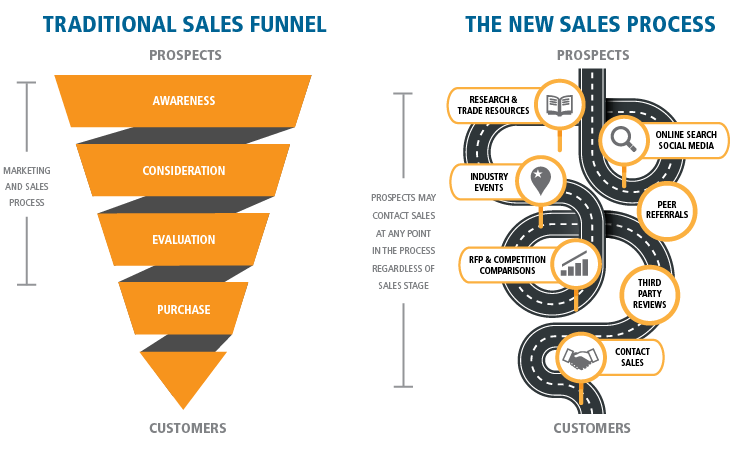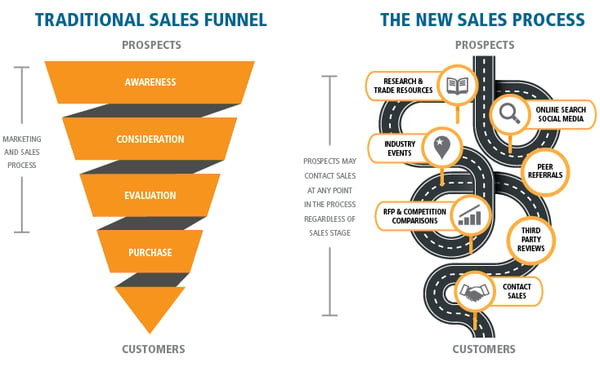
Written By: TMSA Staff | Jan 4, 2018 12:00:00 AM
Part 1 of a 2-part series on how emerging technologies, more immediate access to market data, and changing needs in transportation and logistics have become disrupters of the traditional sales funnel.
There's no question that sales activities are becoming more personalized, complex, and dictated by today's buyer of transportation and logistics products and services.
In fact, a recent study by CSO Insights underscores this: Rising customer expectations, combined with a complex and constantly changing selling world, are driving the need for sales organizations to evolve their sales processes and enablement to a more dynamic, strategic, and customer-centered approach. It's time to accept that buyers now hold the power and that this empowerment is only going to grow as accessibility to market information expands.
Historically, transportation and logistics companies have been slower to react to changing customer preferences. But the impact of this paradigm shift is significant, and organizations that don't change clearly will get left behind.
What's Our New Sales Funnel Model?
It used to be a popular business model in our industry: The sales organization had a linear sales funnel where everyone enters the sales process at the top of the funnel and follows a similar buying experience. However, buyers now have immediate and expansive access to more market data, information and business tools. In just a couple of clicks, buyers now can find how other companies have solved similar problems, get recommendations on which partners/providers can best help them, compare overall products and services, get relevant reviews, and even receive quick proposals and pricing. In most cases, they can do all of this easily - sometimes without evening needing to speak live with a single sales rep. Certainly this industry continues to be one based on relationships, but this dynamic is quickly changing.
In fact, recent studies show that B2B buyers are more than 60 percent through their "buying journey" before ever engaging in communication with a sales rep. More and more buyers are adopting this online self-serve approach because it’s more efficient to troubleshoot their own problems and needs without being sold to, get answers online to their buying questions, and most importantly, form opinions in a non-biased way without the influence of direct sales.
These changes in the buyer's journey mean dramatic changes in the buying and selling processes. Buyers now can enter the sales pipeline at various points in the buying process. Some buyers may engage sellers at the beginning of their search because they read an article in Inbound Logistics, Transport Topics, or the Journal of Commerce that links to the seller’s solution and downloaded some gated content. However, other buyers will have done more research and already made comparisons of products and services from the different solution providers before even engaging in conversations with the seller. There even could be other buyers who have already selected their preferred provider or carrier through research and reviews, and have already connected with sellers for the first time to negotiate pricing.
And to make things even more complicated, how buyers enter the sales pipeline might not be indicative of where they are at in their own buyer's journey. Just because a buyer requested pricing information on a provider or carrier's website doesn't mean they are in the negotiation phase of their buying journey. Or a buyer who downloads a whitepaper might be further down the pipe than their action indicates.
Today's new model of a sales funnel perhaps may not even be a funnel at all. It could be a comprehensive, complex maze of individual buyer paths intersecting at various sales and marketing touch points.
What Do These Changes Mean for You?
These market changes have serious implications for all sales organizations - whether you're a 3PL, motor carrier, railroad, ocean carrier, or technology innovator. Primary questions facing sales management include:
These are just a few of the questions sales organizations that need to be answered to continue to grow revenue and profitability moving forward. TMSA goes deeper into these implications in Part 2 of this series and explore what sales teams must do to effectively adapt to this new selling environment.
Interested in learning more about how to maximize your marketing budget?
Join TMSA and visit the Members Only Website for valuable resources or whitepapers on this topic.
Download TMSA's Whitepaper: "The Disruption of the Traditional Sales Funnel"
Tags: Sales